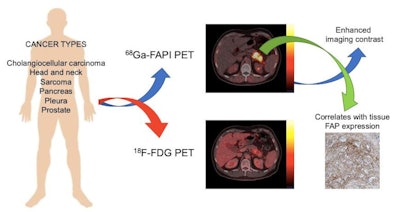
Gallium-68 (Ga-68) fibroblast activation protein inhibitor (FAPI) PET imaging may improve tumor detection in cancer patients over conventional imaging, according to a study published December 30 in the Journal of Nuclear Medicine.
A group led by Dr. Nader Hirmas of the University of Duisburg-Essen in North Rhine-Westphalia, Germany, analyzed preliminary data from a prospective phase II study of Ga-68 FAPI-PET compared with F-18 FDG-PET in patients with sarcoma, pancreatic carcinoma, and primary brain tumors. According to the findings, Ga-68 FAPI-PET may be considered a new tool for tumor staging, the authors wrote.
"Ga-68 FAPI demonstrates higher absolute uptake in pancreatic cancers and sarcoma, as well as higher tumor-to-background uptake along with improved tumor detection for pancreatic cancers, sarcoma, and other tumor entities," they explained.
Fibroblast activation protein (FAP) is overexpressed by cancer cells, and researchers suspect it is an essential component driving the growth of tumors. Experimental FAP-targeted molecular imaging radiotracers, such as FAPI-04 and FAPI-46, have shown promising results in tumor diagnosis.
In this study, the researchers culled data from patients enrolled between October 2018 and October 2021 in a clinical trial to test the safety and diagnostic accuracy of Ga-68 FAPI-46 versus FDG-PET for different FAP-expressing cancers. They identified 324 patients with 21 different tumor types who underwent Ga-68 FAPI imaging and 237 patients who additionally received F-18 FDG PET scans. The most common tumor types were sarcoma (40%), pancreatic carcinoma (21%), and primary tumors of the brain (7%).
 Graphical abstract. Image courtesy of the Journal of Nuclear Medicine.
Graphical abstract. Image courtesy of the Journal of Nuclear Medicine.Tracer uptake for tumor lesions was quantified by maximum standard uptake (SUVmax) values. The team also calculated PET tumor volume, tumor-to-background ratios (TBR), and assessed correlations between SUVmax and FAP staining in lab tissue samples.
The investigators found that Ga-68 FAPI outperformed F-18 FDG across a variety of measures for pancreatic cancers and sarcomas.
| Comparison of Ga-68 FAPI and F-18 FDG for identifying cancer on PET imaging | ||
| Measure | F-18 FDG | Ga-68 FAPI |
| Mean primary tumor SUVmax | ||
| Pancreatic cancers | 6.1 | 13.2 |
| Sarcoma | 9.4 | 14.3 |
| Mean SUVmax | ||
| Metastatic lesions of pancreatic cancers | 5.5 | 9.4 |
| Mean primary TBRmax | ||
| Pancreatic cancers | 3 | 14.7 |
| Sarcoma | 4.7 | 17.3 |
In addition, among 61 histopathology samples, there was a positive correlation between Ga-68 FAPI SUVmax and overall FAP immunohistochemistry score, the authors reported.
"Ga-68 FAPI PET is a promising imaging modality for these entities, and it has the potential for more precise staging and management of patients as well as theranostic screening," they concluded.



















